“Because nobody wants to get rich slow.”
Yet that’s exactly what Warren Buffett, quoted above, did.
And to great success.
Since the ripe old age of 11, Buffett has always taken a slow-but-steady approach to investing — an approach that he put to the test in a bet against several hedge fund managers. Ultimately, his long-term, hands-off investment in simple and affordable index funds performed the best.
It really is such an achievable strategy.
But still, so few people choose to follow in the footsteps of one of the wealthiest people in the world.
Why?
Because for those of us without superhuman patience — Buffett clearly excepted — our emotions often get the best of us.
In trying to create a sense of control and soothe the stressors in our lives, we make decisions more geared toward instant gratification than sustained growth.
We see this same thought process impact marketing decisions All. The. Time.
Marketing managers, assuaged by the promise of a flurry of fast traffic, splash out on pricey PPC campaigns. Unfortunately, just a short time later, they rarely have any new users or qualified leads to show for it.
Just like in the investing world, triumph in the marketing realm — especially in the highly-competitive SaaS space — requires planning and patience.
Keep reading for the stories of how four SaaS companies large and small deployed long-term, content-led SEO strategies to grow engaged blog traffic, leads, brand awareness, and beyond.
What is SaaS SEO?
The prevalence of software-as-a-service (SaaS) platforms continues to grow so quickly they even made up a name for it: the SaaS explosion.
What does that mean for you, the SaaS marketer?
It’s your time to shine.
Being the best product isn’t quite enough anymore.
The internet has become the great equalizer in many cases, lowering the barrier to entry and positioning you right alongside 100 of your biggest competitors. Today, you must find a thoughtful way to rise above the noise.
To really catapult growth now, it’s all about a marketing strategy.
Marketing strategy that acquires qualified leads, that closes sales, and that does it all sustainably.
Marketing strategy that hinges on SaaS SEO.
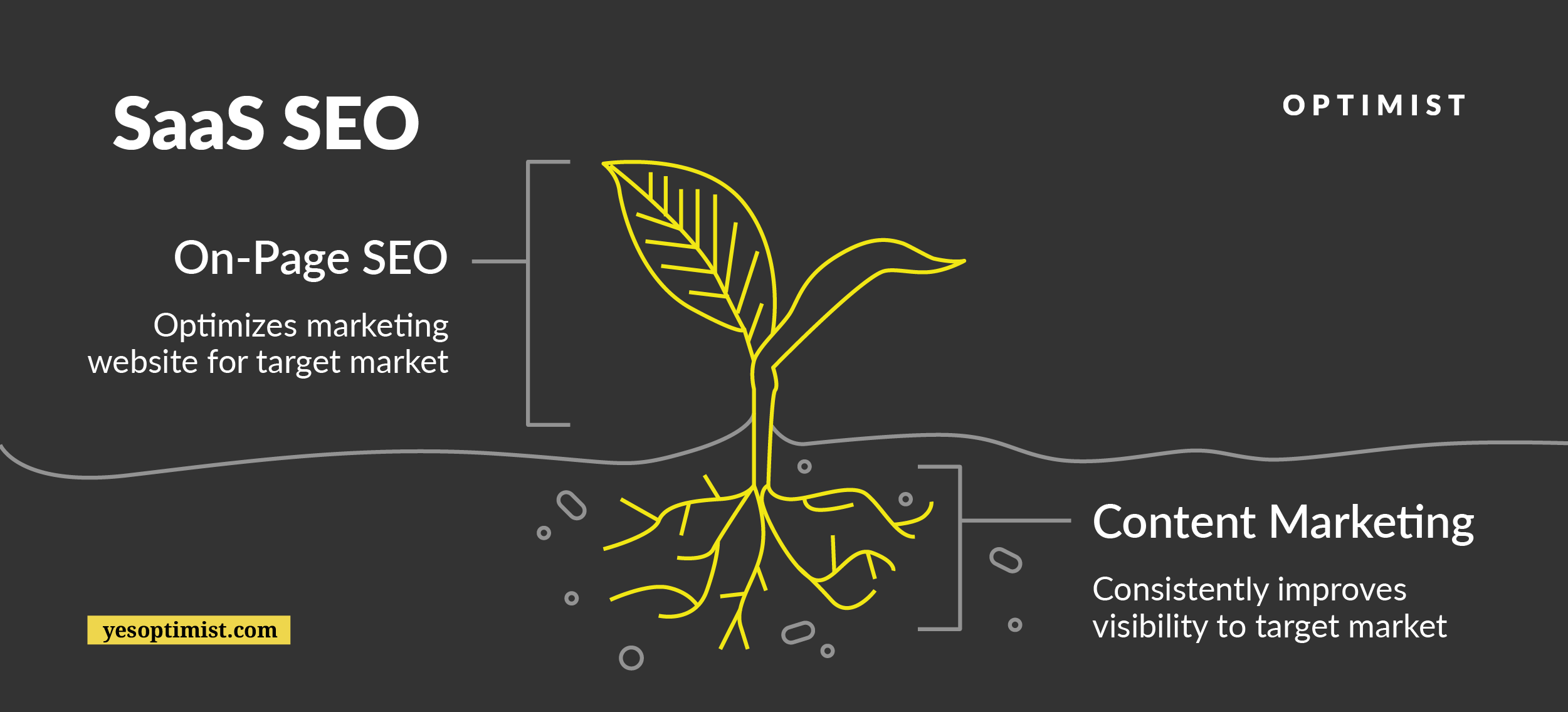
SaaS SEO strategy aims to help SaaS websites appear on the first page of search engine results pages (SERPs) when people search for certain terms. Then, once those people land on your SaaS website, provide valuable information that converts them into users or leads.
There are two main tactics that make SaaS SEO work well:
- On-page SEO Optimization: An initial acquisition strategy that includes updating your SaaS marketing website to take advantage of the latest technical SEO strategies and using keywords in context across its pages
- Content Marketing: Long-form content (blogs, whitepapers, etc.) incorporates keyword research and provides deep value, further engaging qualified leads and moving them through the marketing funnel toward conversion and retention
Just as vital as understanding the foundational elements of SaaS SEO is seeing it in action to understand how those elements play together in real life.
So let’s explore some case studies to uncover the SaaS SEO methods that startups and large SaaS companies alike employ to generate relevant traffic, increase sales leads, and more.
Case Study 1: The SaaS SEO Strategy That Helped HelloSign Grow Organic Traffic 1,308%
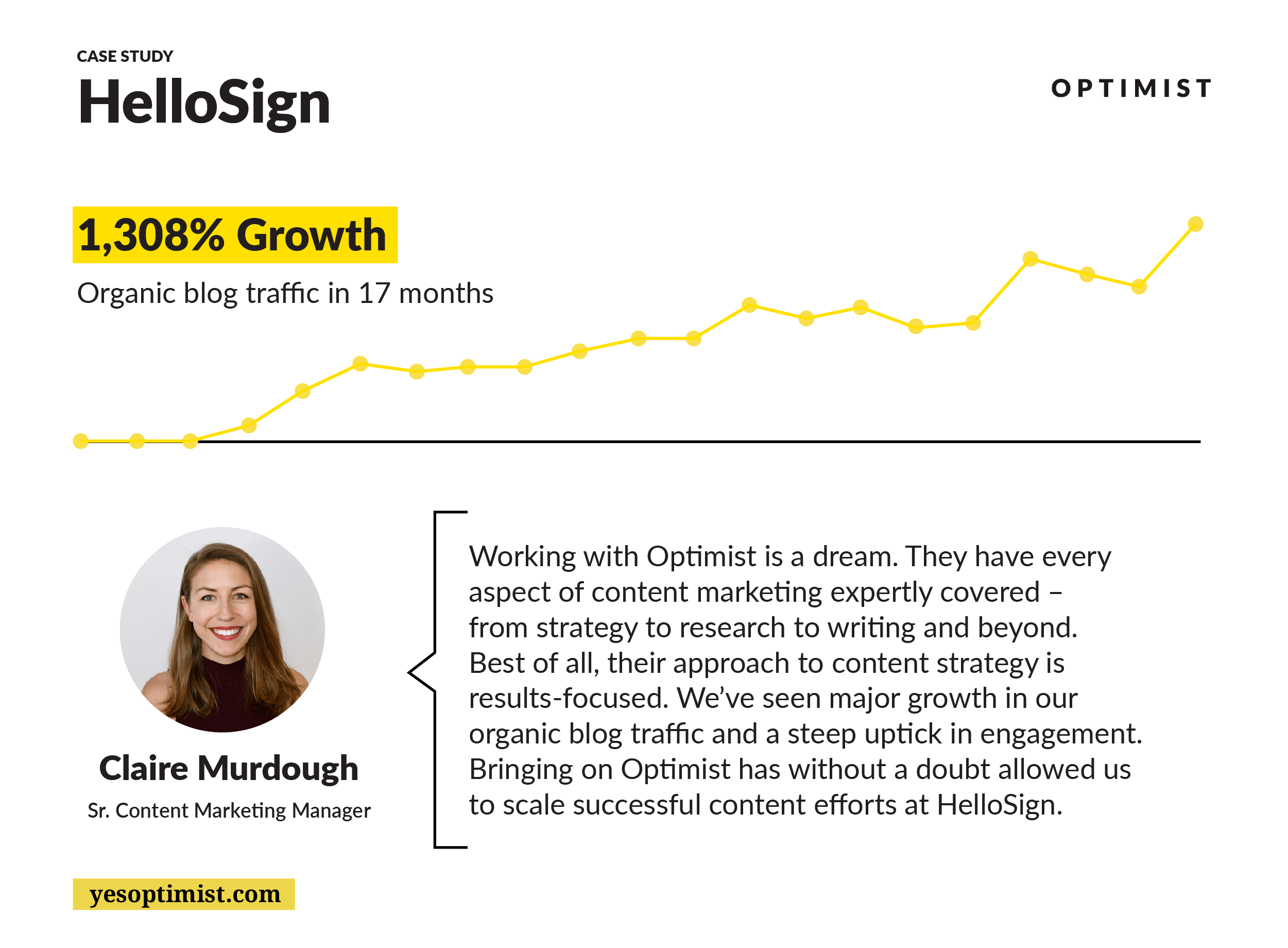
With a $230 million dollar acquisition by file hosting giant Dropbox in 2019, it’s clear HelloSign (now officially Dropbox Sign) was doing a lot of things right.
One of those things being, of course, overall business growth. Interestingly, HelloSign’s business growth up to its acquisition coincided perfectly with another type of growth: organic traffic growth.
Organic traffic growth of 1,308% over 17 months working with Optimist, to be precise.
How did we do it?
As a SaaS content marketing agency, our primary goal was building out the content marketing element of the two-part SaaS SEO strategy (reminder: on-page optimization + content marketing) for HelloSign.
We did so by applying a customized version of our SaaS content marketing framework, which we created with the typical SaaS business model and buyer journey in mind.
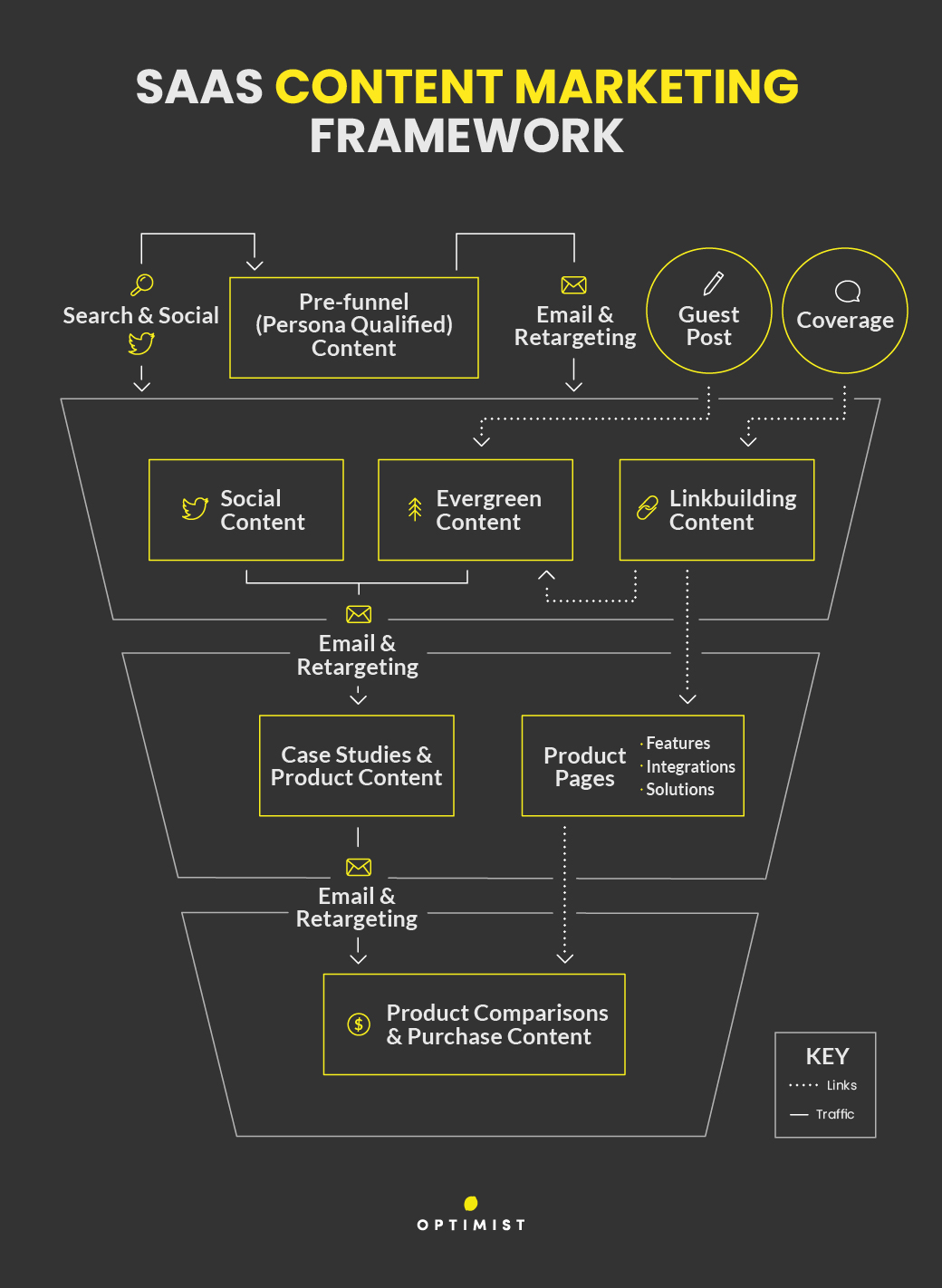
In the case of HelloSign, our business objective was three-fold:
- Drive product signups (priority)
- Grow relevant traffic
- Increase product awareness
Clearly, a well-planned and ongoing strategy would be vital to creating a blend of marketing content that provided value to the reader and value to the company.
Here is a much-abridged version of the cohesive SaaS content marketing plan we came up with to propel HelloSign’s organic search traffic, and business, growth:
1. Outline Content Marketing Baseline, Metrics, And Goals
Good content marketing isn’t cookie-cutter — it’s shaped by the company’s objectives.
Some common goals for SaaS companies include growing website traffic, signups (this was HelloSign’s main goal), brand/product awareness, leads, email subscribers, payment upgrades, adoption within existing customer accounts, retention, customer lifetime value, and more.
Once you know your goals — we recommend having no more than three and designating one as primary — you can start to think about the metrics you’ll use to measure progress. For example, what does retention look like? A user staying on your platform for six months, or six years?
Then, set a benchmark against which you’ll compare metrics in the future to measure success. You won’t know if your content marketing efforts have created more leads if you don’t know how many leads you generated per quarter before starting this new strategy.
2. Define ICP(s)
Another critical step in tailoring HelloSign’s content-focused SEO strategy was understanding who all the content was for. This was especially salient as we were targeting both B2C and B2B SaaS buyers.
We did this, and you can, too, by asking questions like where engaged readers who visit your blog come from, what challenges they’re working with, which other SaaS solutions they’ve considered, their typical budget, and so on.
This all adds up to create an ideal customer profile (ICP), to whom all your content should speak. You might find you need to address a few different ICPs, depending on how many versions of your product you offer, how many types of decision-makers you tend to work with, and other intricacies of your model.
3. Decide on Content Channels and Formats
For most of the SaaS SEO strategies we create, including HelloSign’s, the main distribution channel we consider is search engines, like Google. By creating keyword-targeted blog articles, ebooks, and other long-form content that provide specific information for which ICPs are searching, we are able to generate visitors, awareness, leads, and conversions from search engine traffic.
Other distribution channels include email and social media. And other content formats include webinars, infographics, and podcasts.
4. Plan Content for Each Step of The Saas Content Marketing Funnel
For most SaaS businesses, there are four main areas in the marketing funnel:
- Pre-Funnel content: Content in this stage is for the ICP who isn’t necessarily looking for a solution, but likes to read about industry insights and tooling. Example content: industry-related podcast that doesn’t necessarily convert, but does boost awareness
- Top-of-Funnel Content: Readers here are looking for answers to challenges, but aren’t shopping for a specific tool yet. Example content: evergreen ebook that resolves a common pain point while featuring a step that your SaaS solution can help with
- Middle-of-Funnel Content: Readers who click on this type of content are open to purchasing a solution, and may be on your blog because they’re considering yours. Example content: how-to infographic walking readers through using your SaaS solution for a specific task
- Bottom-of-Funnel Content: Go ahead and make that pitch, because readers who engage with this content are ready to sign up for something and are doing a final review of their top options. Example content: tool 1 vs. tool 2 blog post
5. Create, Distribute, Iterate
We create what are typically known as content calendars for all of our clients here at Optimist, but it’s not the dates that make them valuable.
What we’re really trying to do with these calendars is make sure we’re covering our star keywords in depth. We use calendars to plan at least one piece of pillar content for the main keywords we want to target — say, “esignatures” in the case of HelloSign — then several pieces of content featuring related keywords, which link back to that pillar piece. Our calendars help us make sure we’re covering all of that ground before moving on to the next cluster of keywords.
The actual dates when you create, publish, and distribute content to your chosen channels aren’t nearly as important as just doing it as regularly and sustainably as possible.
Now that your content is out there in the world there’s just one more thing to do, which we also did for HelloSign as part of its content-focused SaaS SEO journey with us: iteration.
It’s time to go back and visit your metrics, goals, and baselines to analyze performance. Don’t be afraid to improve upon your strategy by creating new content, using new formats, researching new keywords, and even refreshing and republishing existing content with new information.
Read the full breakdown of our SaaS content marketing plan for HelloSign.
Case Study 2: 3 Content Tactics That Helped Fuel Buffer’s Rise to $18MM ARR
Famed for their radical transparency and remote structure — a truly revolutionary idea back in 2012 when it was introduced — today Buffer generates over $18 million in ARR.
How does the social media management platform do it on just under $4 million in funding throughout their lifetime?
- A great product, to which they’re always adding features.
- The strong community they’ve created around their brand.
- Good ol’ content marketing that organically brings new customers into their orbit.
Here are three of the tactics we’ve seen Buffer apply over the years to create content that brings in organic users and, with them, revenue and company growth.
1. Guest Posting
In the days before Buffer was a recognized name, its cofounders latched onto an affordable way to get their tool in front of their target audience without pouring a bunch of money into ads: guest posting on blogs that catered to the marketers, small businesses, and other personas they wanted to reach.
By creating super valuable guest posts that included details on how Buffer itself could improve the readers’ social media strategies, Buffer was able to drive targeted, organic, and affordable traffic.
2. Curating Popular Content
Success in SaaS SEO is ultimately about creating the most high-value content you can — then getting it in front of the right people to multiply its impact.
If you don’t have the resources to create that kind of content from scratch every time, the secret lies in well-researched curation.
Buffer finds success with this tactic by figuring out a topic their audience is into — SEO research to the rescue — then gathering tons of info on that topic from dozens of trustworthy sources. The results are some truly epic guides that don’t require weeks of original research yet are wildly helpful for their readers.
3. Repurposing Content for More Channels
If you read the above case study about the SaaS SEO tactics we used to help HelloSign grow, you’ll see we’re on the same wavelength with Buffer.
That’s because another one of the company’s content marketing tricks is all about repurposing content that’s already pulling its weight.
Buffer takes blogs that are driving traffic then chops them up into videos, graphics, slideshows, a series of Tweets, and other formats. Then, they push these pieces of content out across the various channels for which they were created (Twitter, YouTube, Facebook, etc.). This is another way that Buffer, and anyone who emulates their strategy, can save resources yet still create clever content marketing they know will connect with the intended audience.
Case Study 3: This SaaS SEO Strategy Makes Drift an Authority in the Conversational Commerce Space
If you’ve used a chatbot on a website recently, there’s a chance you’ve interacted with Drift.
The unicorn SaaS company brings conversational commerce — the practice of engaging customers in digital conversations to make sales — to the B2B space through its artificial intelligence (AI) platform.
Companies are expected to spend around $290 billion on conversational commerce by 2025. In 2021, Drift helped more than 50,000 businesses generate $5 billion in value.
What’s one of the core SEO tactics this billion-dollar business employs to ensure they’re an authority in the competitive conversational commerce industry?
The pillar-cluster approach (another strategy we applied in our work with HelloSign).
Here’s a simplified walkthrough of how this SEO tactic takes shape:
1. Initial SEO Research
Think about broad topics that relate to what your SaaS offers. In the case of Drift, these topics would include things like conversational commerce, conversational marketing, chatbots, and more.
Use an SEO research tool to nail down a few of these larger topics that you have a chance of ranking for through content.
2. Build Your Pillars
Each pillar page should target one of the broad keyword phrases you chose. Pillars can be either blog posts or landing pages. Whatever format you choose, this is where you want to spend a lot of time making these resources as comprehensive and actionable as possible for readers.
For example, you can see that Drift decided to double-down on chatbots as one of their pillar pages.
3. Build Your Clusters
Dive deeper with your SEO research tool to identify keywords that relate to more bite-size elements of your pillar content. In the case of Drift, they focused on topics like how to create a chatbot, chatbot examples, and so on.
As each of these cluster resources is created, it’s important that each includes backlinks to the pillar page, and to each other. The pillar page should also be updated regularly to link out to all new cluster pages.
4. Add Pillar URLs to Navigation (Optional)
While it’s optional, many companies will include all or some of their pillar pages in the navigation of their website. You’ll usually see them in the footer. This can help signal to search engines, and site visitors, that these pages are important.
The pillar-cluster content strategy is all about positioning your website as a topical authority — like Drift has done with chatbots.
Internal linking is one of the signals Google relies on to tell it that a website is a credible source for a specific topic. So, the more valuable resources chock full of internal links to other value sources your website has, the more authoritative Google (and other search engines) consider you — which prioritizes your site in searches.
Case Study 4: How Content Helped This SaaS Company’s Leads Climb 571% in Just 5 Months
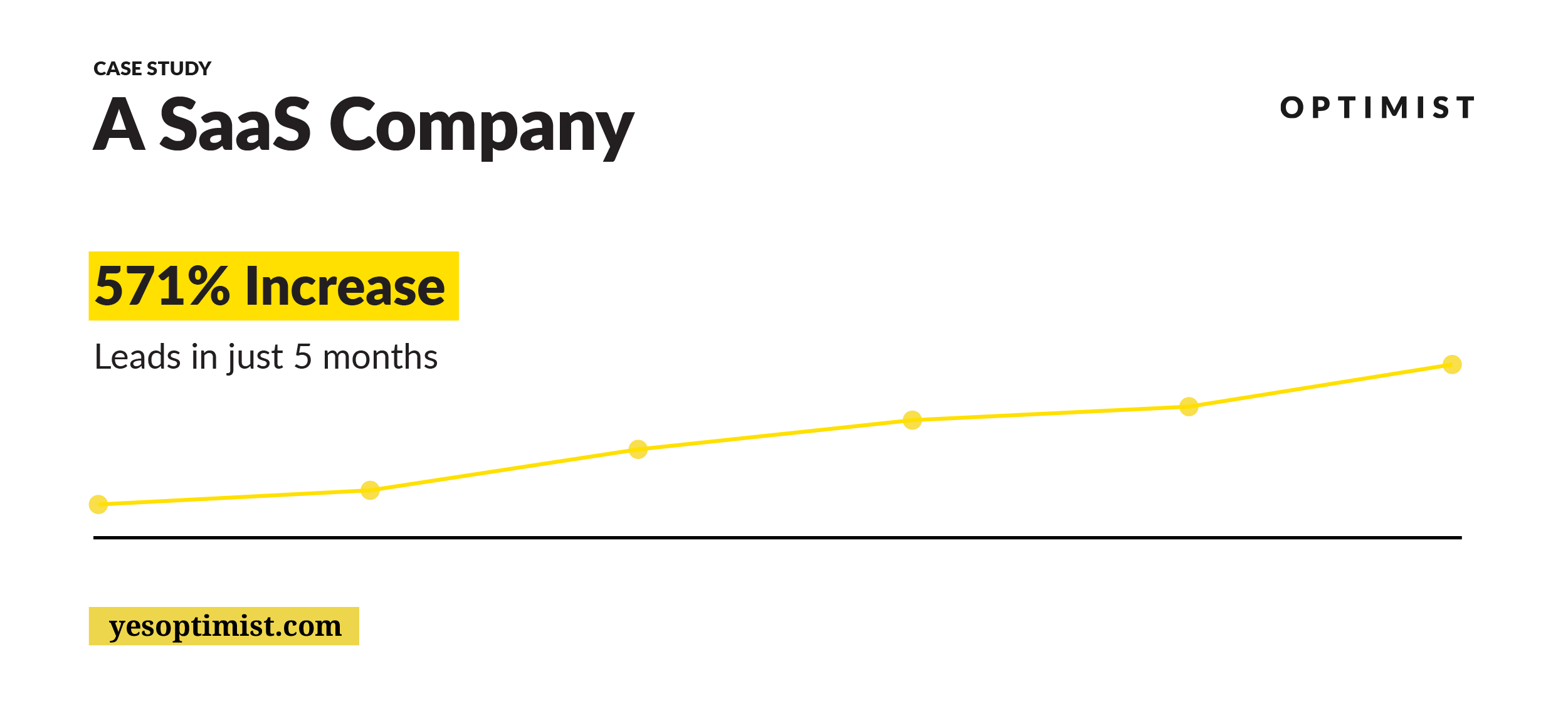
How about we round things off with a SaaS lead generation case study?
In just five months, Optimist was able to help one SaaS company increase its traffic by 254%.
But that’s not all. At the same time, we grew its leads — the main objective — by 571%.
After interviewing several other marketing agencies, they ultimately partnered with us because we understand that a customized, holistic content marketing strategy is required to engage leads throughout the customer journey.
Here are the steps we took to help this SaaS organization build its pipeline of high-quality leads:
1. Identify Jobs To Be Done
We know the reason most people buy software is that they have a specific need or goal in mind, and believe the solution they’re purchasing will help them with it. So, the trick was to understand what those needs and goals were and create content that spoke to those.
In order to do that, we applied the jobs to be done (JTBD) framework.
In the SaaS space, JTBD is about honing in on exactly what tasks the customer hopes to complete using your software. By creating content that answers how they can do each and every one of these tasks, you’re more likely to align with their jobs to be done and convert them into a user.
How do you figure out JTBD?
- Develop ICPs
- List each of your specific software features
- Identify which tasks each feature solves for one or more of your ICPs
For example, for this SaaS company that sold a sales tool for generating more prospects, some of those jobs included automating prospecting, qualifying MQLs, scaling sales ops, etc.
That list of tasks is the list of topics you’re going to develop target keywords and top-of-funnel content around.
2. Use Gated Content to Capture Qualified Leads
The truth is that most people entering near the top of the funnel aren’t going to convert simply from reading one or two pieces of content.
You need a plan for taking readers from just relevant traffic to actual leads who show both fit and intent.
This means connecting that JTBD-focused content to actions that move readers down the funnel and closer to conversion.
We’re not talking newsletter subscriptions or downloading a free template — that creates contacts, not qualified leads.
What we’re talking about is highly-specific gated content or other offers that signal that the person sharing their info has genuine intentions to engage with your product. Aka, they’re a qualified lead.
These offers should be tailored to the content at hand and distinctly signal that the lead really has the potential to convert. For the client in this case study, we created these offers for nearly every piece of upper-funnel content we wrote.
To really drive home the success of this strategy and effectively move leads toward conversion, we helped this client build a custom, email-based content nurturing sequence. That kept leads engaged with a trickle of new content that aligned with the JTBDs we knew they were interested in.
While building sequences is a one-off service we don’t typically engage in, it’s certainly something you can replicate in your SaaS marketing strategy to boost conversions.
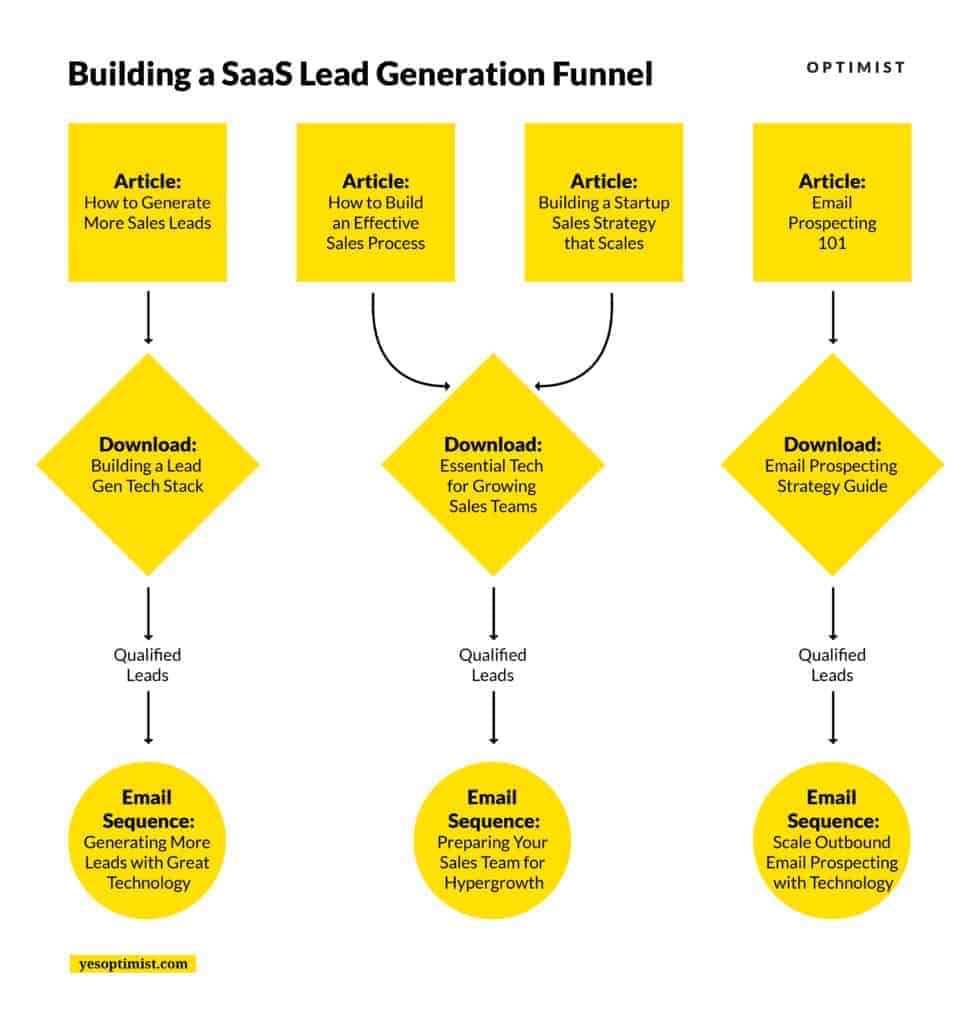
In addition to these core strategies, other things that helped this SaaS business grow traffic and leads included:
- Optimist also developed down-funnel content around product and solution keywords to cater to those folks who were already mid-funnel
- We enacted a link building strategy to increase authority so that we could rank for those more competitive down-funnel phrases (link building is something we no longer offer at the time of this writing)
- The client also invested in a paid acquisition strategy to further scale lead growth
While we can’t own our client’s entire sales funnel, this case study shows how Optimist partners as closely as we can with our clients to support business goals — whether that’s more signups, more traffic, or 500%+ more actionable leads.
Get the full scoop on our SaaS lead generation tactics for this client.
If you liked the above stories, check out more content marketing case studies for a peek into how Optimist has partnered with brands like Contenstack, Stampli, FairShake, and others to build powerful content marketing and SEO strategies, grow website traffic by almost 7,000%, increase organic conversions by over 4,000%, and beyond.
The Secret Behind These Uber-Successful SaaS SEO Strategies
The secret sauce behind these and every other successful client we’ve worked with is a combo of careful strategizing, hard work, and very importantly lots of time.
No get-rich-quick style schemes will work here and the gratification will rarely be immediate. Success in SaaS SEO requires a sustained investment in user research, content creation, measurement, and iteration.
Hiring a full-service partner agency like Optimist where 5-7 specialized experts will work on your content should run you the cost of one to two FTE salaries. Of course the final number depends on scope, objectives, and other factors.
An in-house team should include three to five FTEs. While the cost to you will be higher in this case, the long-term value is probably better as long as you intend to stick with content marketing.
In fact, we created a whole guide to hiring a content marketing agency which you can check out for more help making this critical decision for your SaaS company.
The path we’ve seen most of our customers take is first working with Optimist to experience the magic of content marketing — then building their own in-house team to make that magic on their own.
What can we say, we know how to make content marketing ridiculously good looking.
Work with us to see for yourself.